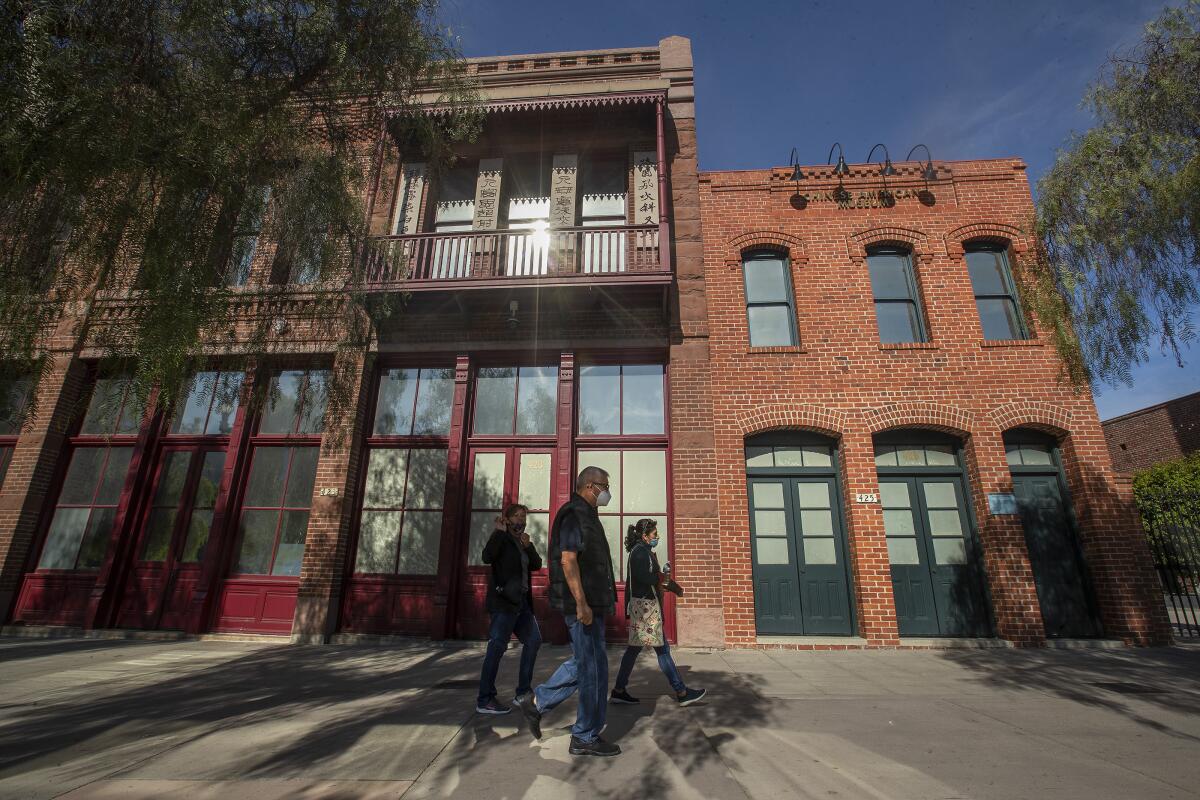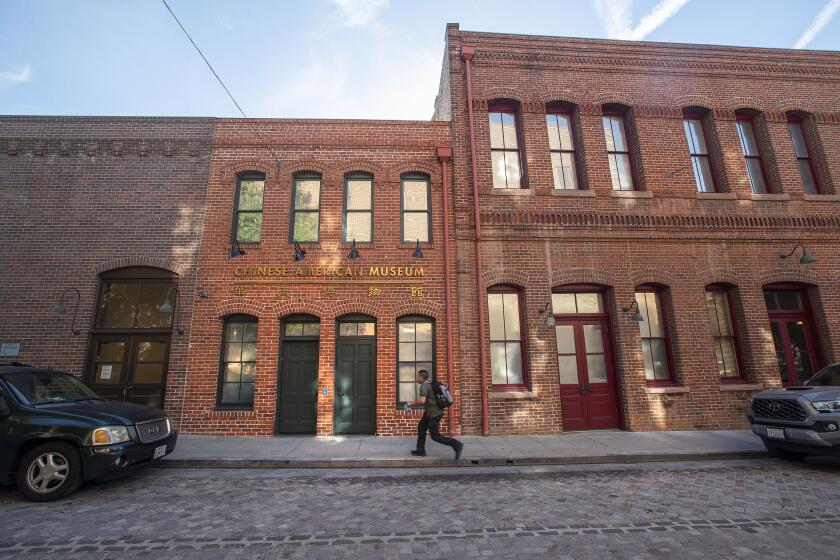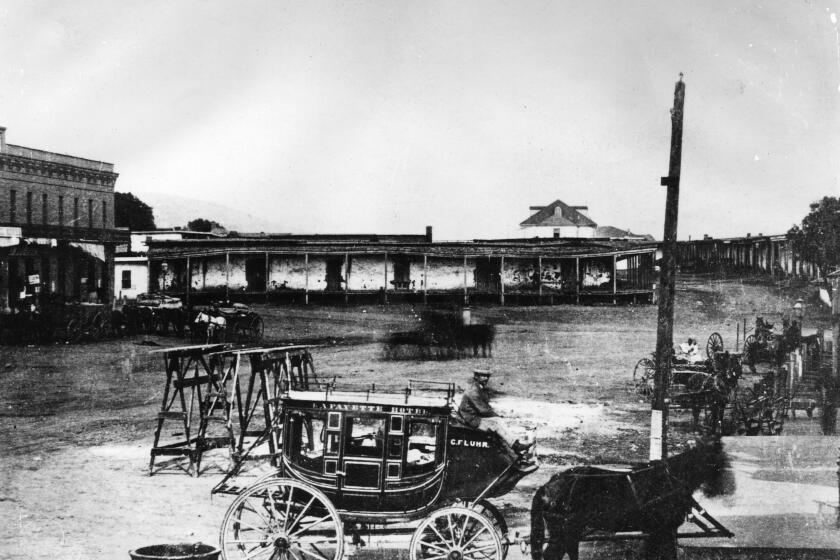An L.A. mob once massacred 18 Chinese people. Now, a push to never forget the racist assault

It happened in the early days of Los Angeles, when the city was a dusty, violent, frontier town.
An eruption of gunfire around 4 p.m. on Oct. 24, 1871, spurred what’s believed to be the most lethal example of racial violence ever recorded in the city — the Los Angeles Chinese massacre.
Hundreds made up the largely white mob that descended upon what’s now downtown Los Angeles. They indiscriminately beat, shot or hanged any Chinese person they saw.
“Then, every rickety shanty in Chinatown was looted. ‘Boys, help yourselves,’ was the cry,” according to an account of the lynchings published by The Times in 1999.
The spasm of violence left at least 18 Chinese people, an estimated 9% of L.A.’s Chinese population, dead at a time when the city barely registered 5,700 people. The victims included the Chinese community’s only physician, Dr. Gene Tong.
The news made national headlines, marking the City of Angels as a frontier town rife with violence and lawlessness. Embarrassed city leaders built up the police department and tried to restore the rule of law. Eight of the attackers were tried but eventually released, and a small sum was paid to the Chinese government as an apology.
But in a city long accused of bulldozing its history, the area of the massacre was redeveloped and the Chinese community rebuilt in a different location.
Today, that history is largely forgotten.
A bronze plaque embedded in the sidewalk outside the Chinese American Museum on Los Angeles Street stands as a rare memorial. It’s smaller than a pizza box.
More than 150 years later, city officials have put out a public call for ideas to memorialize this history.
Two reports — by the city of L.A. and Monument Lab — reveal blind spots in how California marks its history. A memorial to the Chinese Massacre sets a new agenda.
Mayor Eric Garcetti, the city Department of Cultural Affairs, the office of Councilmember Kevin de León and El Pueblo de Los Angeles Historical Monument released a request for ideas on Friday to develop a memorial to the victims of the 1871 Chinese Massacre.
“We are ... awakening to the fact that so much of U.S. history is covered history or underreported history or inaccurate history,” said Gay Yuen, Friends of the Chinese American Museum Board of Directors chairperson. “This history is our story. It’s who we are and what we are. This memorial is important because it allows us to unfold and point to a segment of U.S. history, of L.A. history, that’s been buried for 150 years.”
Friday’s request for ideas is the culmination of a year-long community engagement effort that sprung from recommendations in the 2021 Past Due report from the Mayor’s Office Civic Memory Working Group, according to a statement by Garcetti’s office.
Officials aim to have initial conceptual proposals for the memorial in hand by Oct. 12, the mayor’s office stated. A panel of arts and design experts will evaluate the submissions and select up to five artists or teams who will each receive a $15,000 stipend to further develop their concepts and present them publicly.
City officials will select a finalist in the week of March 13, 2023, according to Friday’s announcement.
“Our Chinese and Chinese American communities — then and now — are critical threads in the fabric of our rich cultural tapestry,” Garcetti said in a statement. “The 1871 massacre of innocent lives is a stain in our history that no monument can begin to erase. This memorial will serve as a public commemoration of the lives lost and a warning against senseless violence within our own communities.”
Councilmember Kevin de León, whose district includes all the areas where the massacre took place, called the violence “one of the most savage and horrific events in our city’s history.”
Creating a memorial is necessary to honor the lives lost, become a city that’s transparent about the shameful parts of its history and to reconcile with that past, De León said.
“We owe it to all Angelenos to be honest about our past — the good and the bad,” he said.
Former City Councilmember Michael Woo has long been an advocate for a memorial about the massacre.
The community is very grateful that the time has come to reckon with this part of Los Angeles history, Woo said.
“The fact that city of L.A. is really stepping up, not just with symbolism but making a financial commitment, it means a lot to Chinese Americans and other Asian Americans,” he said.
The project’s leaders hope that a design will emerge that speaks to the public at large, not just to the Chinese American and Asian American communities, about racial violence, said Woo, who co-chairs the steering committee with Yuen and three others.
The memorial, he said, won’t only be a statue on a pedestal.
The steering committee is inviting proposals for memorials on two primary sites within the El Pueblo de Los Angeles Historical Monument, where the massacre occurred, according to documents provided by the city Friday.
Respondents can choose one of the two primary sites as well as any number of secondary sites related to the killings, which will be linked as a walking tour, audio guide, landscape design, QR code or by some other interpretive means, according to the documents.
Although some of the secondary sites were locations of violence, others mark where Chinese people fleeing the massacre were offered sanctuary by Angelenos who opened their homes or property, city officials said.
“The massacre in 1871 was not only the biggest mass killing of Chinese in California history, but the biggest mass killing of any kind in Los Angeles history,” Woo said. “L.A. in the 1870s was considered a Wild West town. It was one of the most lawless places west of Arizona and New Mexico. It’s hard to imagine what it was like.”
He hopes the memorial will help Angelenos understand the connection between their current city and that history.
The Los Angeles Chinese Massacre was not an isolated incident. Anti-Chinese violence and politics have shaped American citizenship and immigration policy.
Yuen said she and the committee’s other members hope to get submissions from a variety of artists and firms, and not limit the project to those with wealth and significant resources.
The city has set aside $250,000 to help emerging artists and those who would otherwise lack the resources to participate, she said. While the funding won’t be enough to build the memorial, it will cover $15,000 stipends for each of the five shortlisted artists or teams.
City officials are also not charging submission fees in an effort to ease artists’ financial burden, according to the request for ideas.
Garcetti called for the memorial during his 2021 State of the City address and issued the first official apology on behalf of the city during an Oct. 24 vigil at the Chinese American Museum.
To go along with the city-sponsored memorial, Yuen said she has secured $2 million in state funding for a unity garden on one of the massacre’s sites.
For more information on the project, how to enter a submission and deadlines for submissions, visit the Los Angeles Department of Cultural Affairs at culturela.org.
More to Read
Sign up for Essential California
The most important California stories and recommendations in your inbox every morning.
You may occasionally receive promotional content from the Los Angeles Times.













